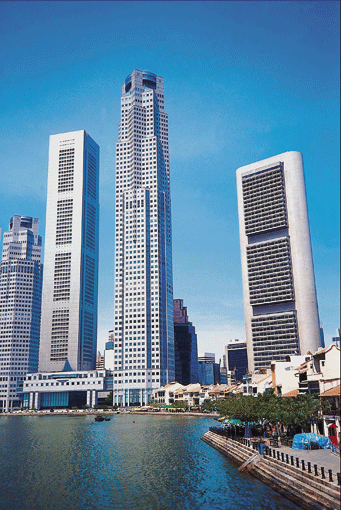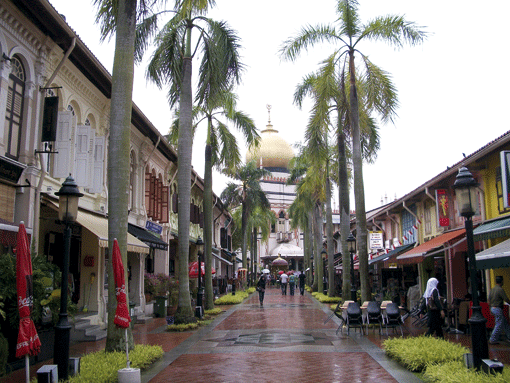
Travel
Cosmopolitan Singapore
A Microcosm of Asia

Wondering Singapore, an ultra-modern city state, is a delightful merry-go-round
with you experiencing the panache of its culture and food.
By: Rufaida Javid
If you litter the streets or parks, you will be slapped with a fine of $ 1,000. And if you are careless enough indulge in vandalism, then apart from being fined $ 5,000, you may also cool your heels for a day or two in the lock-up. It’s not for nothing that Singapore is wryly known as the ‘Fine City’. But this obsession with penalizing offenders has it good points: Singapore is arguably the world’s cleanest city.
The one word that best describes this dynamic city-state is efficiency. Everything seems to work perfectly. The metro train that is scheduled to arrive at 10.13am arrives exactly at 10.13 am—not 10.12 am, not 10.14 am. Traffic flows like clock-work. In fact, there is no such thing as a traffic jam in this most modern of cities. And the drainage system is so perfectly designed that minutes after a long afternoon spell of rain, the roads are clear of any water.
Strict adherence to the principles of the free market, extremely good governance and the entreprenurial spirit of its five million residents has meant that Singapore enjoys one of the world’s highest standards of living. The remarkable success story of this entrepot of capitalism shows that there is no reason why an Asian city cannot be run efficiently, as per the highest international standards.
Writer William Gibson infamously described Singapore as “Disneyland with the death penalty”. However, most people agree that one of the reasons for Singapore’s peace and prosperity is the strict rules and regulations governing the land.
But even Singapore is taking it a bit easy these days. The famous ban on the production, sale and consumption of chewing gum is a thing of the past, for instance. But, ever the kill-joys, the authorities allow its sale only in pharmacies!
Singapore is a truly multi-cultural city. Chinese (mostly Mandarin speaking) make up roughly 75% of the population; Malays about 15% and Indians account for 8%. The remainder is made up of Eurasians and Arabs (most of whom trace their roots to traders from Hadramaut in Yemen). People belonging to various religions and from different ethnic background live in peace and harmony; there has been no outbreak of serious racial or religious violence in living memory. Many credit Singapore’s no-nonsense government with fostering goodwill among citizens of various ethnic backgrounds.
But the credit for founding the place goes to Sir Stamford Raffles, a British colonial officer. It occurred to him, in 1819, that there existed in this quiet, forgotten place the potential for a world-class port. As it often happens when the dreamer is big enough and has big enough friends, his dreams took shape. By 1867, Singapore was incorporated as a British Crown Colony. Today, Raffles Place—the place where he landed, at the Singapore River—is a central business district in the city. One of the best ways of sampling this district is by boat. A lazy cruise along the Singapore River will leave you spellbound at the confluence of the modern and traditional. On the one side, you can see the towering citadels of modern commerce while on the other side you can find the classical Asian Civilizations Museum and the microphone-like Esplanade, a centre for the performing arts. 
Foodie’s Delight
Food is taken extremely seriously in Singapore. It is one of the main topics of conversation. The culinary riches of this city are beyond description. If you tell a Singaporean about a new great place for eating that you have discovered, he will make sure that he samples its delights too.
Our culinary quest began at the outdoor restaurants along the river, which serve some of the most exquisite seafood. And there are few things as special as a long, late lunch with friends and family by the riverside. What’s more, in many of these restaurants, you get to choose your fish, crab or prawns, while they are still alive, in the massive aquariums! Though not cheap—a meal for two can cost you $ 75 (about SR 200)—is simply not something you must miss.
Those who say Singapore is too sterile and lacks culture are simply wrong. This city-state is extremely cosmopolitan, a microcosm of Asia, and this is reflected in the food. At Singapore’s Chinatown, especially on Smith Street, you can find some of the best traditional Chinese cuisine, at prices that are very good by Singapore standards. The only problem is that most of what is on offer is not halal; we hence stuck to vegetarian and seafood.
As you enter ‘Little India’, you will be forgiven for thinking you have been transported to the sub-continent. A vast majority of Indian Singaporeans are of Tamil origin, and Tamil culture dominates in Little India. You can have some of the best South Indian vegetarian food here; a simple meal will cost you no more than SR 10. There are also some very good value-for-money halal non-vegetarian restaurants in Little India. Though the biryani will struggle to match the standards of the Hyderabadi restaurants in Riyadh or Jeddah, it is still not too bad! 
No trip to Little India is complete without a visit to Mustafa’s, a 24/7 departmental store which offers the best bargains in town. Started in the 1970s by an enterprising Indian immigrant of the same name, it is one of Singapore’s landmarks. I couldn’t think of anything that one can’t find here—and at very reasonable prices.
Reserve an afternoon for Kamplong Glam, the old Malay-Muslim quarter of Singapore. It is also simply known as ‘Arab Street’, after the main thoroughfare that runs through the district. The original Arab traders first settled here, though they moved out in first half of the 20th century. The most striking monument in this part of town is the Sultan Mosque on Muscat Street. The original structure was built in 1824 by Sultan Hussain Shah of Johore. Exactly 100 years later, the structure was razed to the ground, as it had fallen into disrepair and the new mosque was built, which was ready for use by 1928. Since then, it has remained unchanged and even today is the largest and most popular mosque in Singapore.
Around the mosque, you will find some of the best Malay and Arabic restaurants in Singapore. One such is the Haji Essah cafeteria; the satay here is mesmerizing!